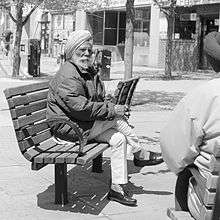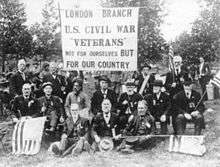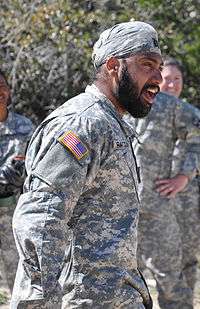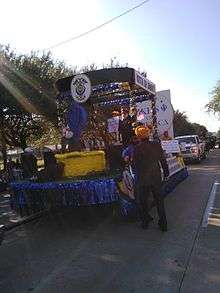Sikhism in the United States
Sikhism is a religion originating from South Asia (predominantly from the Punjab region of modern-day India and Pakistan) which was introduced into the United States during the 19th century. In 2007, there were estimated to be between 250,000 and 500,000 Sikhs living in the United States, with the largest populations living on the East and West Coasts, together with additional populations in Detroit, Chicago, Houston, Dallas, and Indianapolis.[1][2] The United States also has a number of non-Punjabi converts to Sikhism.[3]
 Members of the Sikh community of Somerville, Massachusetts | |
| Total population | |
|---|---|
| 250,000 - 500,000 | |
| Regions with significant populations | |
| Northeastern United States · California · Texas · Virginia · Maryland · Midwestern United States | |
| Religions | |
| Sikhism | |
| Languages | |
| English · Punjabi and its dialects |
| Part of a series on |
| Sikhism |
|---|
 |
|
|
Practices
|
|
|
General topics
|
Sikh men are typically identifiable by their unshorn beards and turbans (head coverings), articles of their faith. Following the 9/11 terrorist attacks, and subsequent other terrorism related activities by Islamic groups, Sikhs have often been mistaken as Muslims or Arabs, and have been subject to several hate crimes, including murders. Sikh temples have also been targets of violence due to being mistaken for mosques. A 2012 shooting at a Sikh temple in Oak Creek, Wisconsin garnered national and international attention, with then President Obama ordering flags to be half-staffed at all federal buildings.
Demographics
Occupations
Military service


Sikhs have served in the United States military at least as far back as the early 20th century, when one Bhagat Singh Thind, who though not a citizen joined the United States Army and served in World War I. Thind requested citizenship at the end of the war, being granted and revoked twice, before finally being naturalized in 1936.[4] Far larger numbers of Sikhs served in World War II, and all American wars following.
The ability of observant Sikhs to serve in the American military has, since 1985, been compromised by a discontinuation of exemptions to uniform standards which previously allowed Sikhs to maintain their religiously-mandated beards and turbans while in uniform.[5] As of 2010, a Sikh doctor, Kamaljeet S. Kalsi, and dentist, Tejdeep Singh Rattan, are the only Sikh officers to be permitted to serve in uniform with beard and turban.[6] In addition, Simranpreet Lamba was permitted to enlist, with exemption to wear his turban and beard, in 2010 due to his knowledge of Punjabi and Hindi.[7]
Policing
In 2016, the New York City Police Department (NYPD) began to allow turbans, subject to standards compatible with unimpeded performance of duty.[8] In 2015, Sandeep Dhaliwal became the first Deputy Sheriff in Texas to wear a turban on duty (Harris County Sherriff's Office). He was shot from behind in 2019 while conducting a routine traffic stop on the Copperbrook subdivision in Houston Texas.[9]
Professionals
Many Sikhs started life in America working in lumber mills, mines, and as farm laborers, with many eventually becoming landowners. Many early Sikh immigrants were restaurant owners. In 1956, Dalip Singh Saund became the first Asian Indian-born person to be elected to the United States House of Representatives.
Elected officials
- Dalip Singh Saund served three terms in the United States House of Representatives between 1957 and 1963.
- Preet Didbal was elected to the position of mayor of Yuba City, California in 2017. She is the first Sikh woman to serve as a city mayor in United States history.[10]
- Balvir Singh was elected to the Burlington County Board of Chosen Freeholders, New Jersey on November 7, 2017. He became the first Asian-American to win a countywide election in Burlington County and the first Sikh-American to win a countywide election in New Jersey.[11]
- City planner Satyendra Huja was elected mayor of Charlottesville, Virginia in January 2012.[12]
- Amarjit Singh Buttar was elected in December 2001 to the Vernon, Connecticut Board of Education and won re-election in 2011.[13]
- United States Ambassador to the United Nations and former Governor of South Carolina Nikki Haley was born a Sikh but later converted to Christianity.[14]
- Ravinder Bhalla was elected mayor of Hoboken, New Jersey in November 2017.
- Satwinder Kaur became the first Sikh elected to the City Council of Kent, Washington in November 2017.
- Manka Dhingra of Washington became the first Sikh woman elected to a state legislature in November 2017.[15]
- Pargat S. Sandhu was elected as mayor of Galt, California on Dec 3, 2019. He became the first Sikh to be elected for City Council and Mayor for the city of Galt.
Settlement
The most concentrated Sikh community in the United States has traditionally resided in agricultural Yuba City, California,[16] although this agglomeration has since dispersed as Sikhs have gained a greater educational foundation, enabling them to have now spread out to metropolitan areas all over the United States. The largest and most rapidly growing Sikh community in New York City is based in the Richmond Hill area of the borough of Queens; the majority consist of more recent emigres from India and Canada.[17] Conversely, in the Sikh Foundation of Virginia, most members comprise both recent and more established Jatt Sikhs and Ramgarhia Sikhs. Most Sikhs of Española, New Mexico are non-Punjabi converts to Sikhism.
History
First immigrants
Sikhs have been a part of the American populace for more than 130 years. Near the end of the 19th century, the state of Punjab of British India was hit hard by British practices of mercantilism. Many Sikhs emigrated to the United States and began arriving to work on farms in California. They traveled via Hong Kong to Angel Island, California, the western counterpart to Ellis Island in New York Harbor.[18]
Some Sikhs worked in lumber mills of Oregon or in railroad construction and for some Sikhs it was on a railway line, which allowed other Sikhs who were working as migrant laborers to come into the town on festival days.[19]
A big effect on Sikh migration to the western states occurred during World War I and World War II, where Sikhs were recruited by the British Army to serve for them. Sikhs fought bravely during these wars and began to live in England after their serving period. Among the Sikhs who already lived in America prior to the wars, many Sikhs joined them, mainly during World Wars I and II. Among those who served in the US military include Bhagat Singh Thind in World War I.
The first Sikh gurdwara in the US was the Gurdwara Sahib Stockton, in Stockton, California; the Gurdwara was created in 1912.[20]
After the September 11, 2001 attacks



As a result of the September 11 attacks, some Sikh Americans have become subject to discrimination, often from individuals who mistakenly believe that they are Arab or Muslim.
Balbir Singh Sodhi, a gas station owner, was killed on September 15, 2001 due to being mistaken for a Muslim. In a 2011 report to the United States Senate, the Southern Poverty Law Center reported several assaults and incidents of arson at Sikh temples after September 11. All were labeled as hate crimes that resulted from the perpetrators' misconceptions that their targets were Muslim.[21] In August 2012, a Sikh temple in Oak Creek, Wisconsin was the site of a shooting, leading to six Sikh individuals being killed.[22] On May 7, 2013, an elderly Sikh man was attacked with an iron bar in Fresno, California in a possible hate crime.[23] On September 21, 2013, Prabhjot Singh, a Sikh professor was attacked in Harlem, New York by a group of 20-30 men who branded him as "Osama" and Terrorist".[24]
A 2007 survey of Sikh students by the Sikh Coalition found that three out of four male students interviewed "had been teased or harassed on account of their religious identity."[25] In 2014, the Sikh Coalition released a national report on the bullying of Sikh children in American schools. The report found that 55.8% of Sikh students surveyed in Indianapolis reported being bullied, while 54.5% of Sikh students surveyed in Fresno, California reported being bullied.[26] According to the surveys, Sikh students wearing turbans are twice as likely to be bullied as the average American child.
Converts
In the 1960s, due to increased Indian immigration and rising interest in Indian spirituality in the American counterculture, a number of non-Punjabi Americans began to enter 3HO. Prominent in this trend was Yogi Bhajan, leader of the Sikh-related movement 3HO (Healthy, Happy, Holy Organization), whose Los Angeles temple was the first to introduce non-Punjabi Americans to Sikhism.[3]
Notable Sikh Americans
- Taegh Sokhey, created the world's first virtual reality Alzheimer's/Dementia tool, entrepreneur, medical researcher
- Ravinder Bhalla, Mayor of Hoboken, New Jersey
- Preet Bharara, U.S. Attorney for the Southern District of New York, 2009–2017
- Gurbaksh Chahal, entrepreneur
- Sant Singh Chatwal, businessperson
- Vikram Chatwal, hotelier and actor
- Harmeet Dhillon, vice chairman of the California Republican Party
- Gurpal Samra, Mayor of Livingston, California, 1996 to current ; first Sikh elected mayor in the United States
- Gurbir Grewal, Attorney General of New Jersey, and former prosecutor of Bergen County, New Jersey
- Narinder Singh Kapany, physicist
- Snatam Kaur, singer, songwriter, and author
- Dharma Singh Khalsa, physician and medical researcher in the field of Alzheimer's disease
- Harpreet Sandhu, member of the Richmond City Council (California), 2007–2008
- Dalip Singh Saund, member of United States House of Representatives from California's 29th district, 1957–1963
- Arjun Singh Sethi, civil rights writer, political rights writer, human rights lawyer, and professor of law
- Balvir Singh, Freeholder, Burlington County, New Jersey
- G. B. Singh, author
- Bhagat Singh Thind, first turbaned soldier in United States Army; plaintiff in United States v. Bhagat Singh Thind, involving an important legal battle over the rights of Indians to obtain U.S. citizenship
- Harbhajan Singh Yogi, yogi, spiritual teacher, and entrepreneur
- Nikki Haley
See also
- Indian American
- Indians in the New York City metropolitan region
- Sikhism by country
- List of gurdwaras in the United States
- Murder of Balbir Singh Sodhi
- Wisconsin Sikh temple shooting
References
- Buddhists, Hindus and Sikhs in America: A Short History, p. 120. Books.google.com. Retrieved 2012-08-10.
- The Racialization of Hinduism, Islam, and Sikhism in the United States, Khyati Y. Joshi, 2006.
- Ronald H. Bayor (31 July 2011). Multicultural America: An Encyclopedia of the Newest Americans. ABC-CLIO. pp. 985–. ISBN 978-0-313-35787-9. Retrieved 6 June 2013.
- Dawinder S. Sidhu, Neha Singh Gohil. Civil rights in wartime: the post-9/11 Sikh experience. Ashgate Publishing, Ltd., 2009. ISBN 0-7546-7553-X, 9780754675532. Pg 137
- "Beard Ban Deters Chabad Rabbis From Becoming Chaplains in Army". 27 August 2005. Retrieved 25 October 2009.
- Michelle Roberts. "1st Sikh in Decades Graduates Army Officer School, Page 1". ABC News. Retrieved 2010-03-22.
- Susanne Kappler (10 November 2010). "Keeping faith: Sikh Soldier graduates basic training". Fort Jackson Leader. United States Army. Retrieved 26 December 2011.
- David Shortell (December 29, 2016). "NYPD changes policy, will allow officers to wear turbans". CNN. Retrieved December 31, 2016.
- "Deputy Who Gained National Attention as First Texas Cop to Wear Turban Shot & Killed on Duty". www.yahoo.com. Retrieved 2019-09-28.
- Willon, Phil. "Meet the nation's first known Sikh woman to serve as a city mayor", Los Angeles Times, December 28, 2017. Accessed January 16, 2018.
- Hefler, Jan. "Race-baiting ads backfired, says Sikh who broke barriers in South Jersey freeholder race", The Philadelphia Inquirer, November 8, 2017. Accessed December 2, 2017.
- "Sikh city planner becomes Charlottesville mayor | Richmond Times-Dispatch". .timesdispatch.com. Retrieved 2012-08-07.
- Tanjua, Damon (November 23, 2011). "School Board Members Make It Official". Vernon Patch. Retrieved August 9, 2012.
- Dewan, Shaila & Brown, Robbie (June 13, 2010). "All Her Life, Nikki Haley Was the Different One". The New York Times. Retrieved August 9, 2012.
- Haniffa, Aziz. "High-stakes showdown in Washington State". IndiaAbroad.com. Retrieved 2018-12-05.
- "American Punjabi Sikhs, Yuba City, California". IIP Digital. US Embassy. Retrieved 9 November 2014.
- Mokha, Kavita (20 August 2010). "New Immigrants Put Stamp on Richmond Hill". Wall Street Journal. Retrieved 9 November 2014.
- The Pioneers, America, "A historical perspective of Americans of Asian Indian origin 1790-1997" 31 October 2006
- Sikhism in North America, America, "Sikhs in North America" Archived 2007-03-05 at the Wayback Machine 31 October 2006
- Stockton Gurdwara, America, "Stockton California" 31 October 2006
- "Anti-Muslim Incidents Since Sept. 11, 2001". Southern Poverty Law Center. March 29, 2011. Retrieved January 12, 2012.
- Matt Pearce; Brian Bennett (5 August 2012). "Gunman's tattoos lead officials to deem Sikh shooting terrorism". Los Angeles Times. Retrieved 5 August 2012.
- SF Gate (7 May 2013). "Fresno police: Sikh beating a possible hate crime". SF Gate. Retrieved 8 May 2013.
- "Indian Professor attacked in Columbia after being called Osama". Retrieved 23 September 2013.
- Sidhu, Darwinder S.; Neha Singh Gohil (2009). Civil Rights in Wartime: The Post-9/11 Sikh Experience. Ashgate Publishing. p. 72. ISBN 978-0-7546-7553-2.
- Juan Orozco; Carmen George (March 13, 2014). "Report: Fresno County Sikh students say they're bullied at school". Fresno Bee.
Further reading
- Atkinson, David C. The burden of white supremacy: Containing Asian migration in the British empire and the United States (U North Carolina Press, 2016).
- Hawley, John Stratton, and Gurinder Singh Mann. Studying the Sikhs: Issues for North America (State University of New York Press, 1993).
- Kurien, Prema. "Shifting US racial and ethnic identities and Sikh American activism." RSF: The Russell Sage Foundation Journal of the Social Sciences 4.5 (2018): 81-98. online
- Mahmood, Cynthia Keppley, and Stacy Brady. The Guru's Gift: An Ethnography Exploring Gender Equality with North American Sikh Women (Mayfield Publishers, 2000).
- Mann, Gurinder Singh et al. Buddhists, Hindus, and Sikhs in America (Oxford University Press, 2008).
- Sidhu, Dawinder S., and Neha Singh Gohil. Civil Rights in Wartime: The Post-9/11 Sikh Experience (Ashgate, 2009).
- Stabin, Tova. "Sikh Americans." in Gale Encyclopedia of Multicultural America, edited by Thomas Riggs, (3rd ed., vol. 4, Gale, 2014), pp. 179-192. Online
External links
- Sikh Research Institute
- Center for Sikh and Punjab Studies at the University of California, Santa Barbara